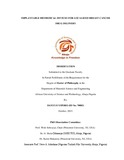| dc.contributor.author | Danyuo, Yiporo | |
| dc.date.accessioned | 2016-05-18T15:43:45Z | |
| dc.date.available | 2016-05-18T15:43:45Z | |
| dc.date.issued | 2015-10-15 | |
| dc.identifier.uri | http://repository.aust.edu.ng/xmlui/handle/123456789/356 | |
| dc.identifier.uri | http://library.aust.edu.ng:8080/xmlui/handle/123456789/356 | |
| dc.description.abstract | This thesis focused on an implantable encapsulated structures that can deliver localized heating and controlled released of prodigiosin (PG) (a cancer drug) synthesized by bacteria (Serratia marcescens (subsp. marcescens)). Prototypical poly-dimethyl-siloxane (PDMS) packages, containing well-controlled micro-channels and drug storage compartments, were fabricated along with a drug-storing polymer produced by free radical polymerization of Poly(N- isopropylacrylamide)(PNIPA)-based gels.
The mechanisms of drug diffusion of P(NIPA)-based gels were elucidated. Scanning electron microscopy (SEM) and optical microscopy were used to study the heterogeneous porous structure of the P(NIPA)-based gels. The release exponents, n, of the gels were found to be between 0.5 and 0.81. This is in the range expected for Fickian diffusion (n = 0.5). Deviation from Fickian diffusion was also observed (n > 0.5). The gel diffusion coefficients were shown to vary between 2.1 x10-12 m2/s and 4.8 x10-6 m2/s. Statistical analyses were carried out on the variations of the data presented using Minitab software package 16. HPLC analysis on the purity of prodigiosin synthesized was determined to be 92.8%.
The effects of localized release of PG and paclitaxel (PT) on cell viability were elucidated via clonogenic assay testing on MDA-MB-231 breast cancer cell line.
The results were validated using models to establish the effective diffusivity of PG and bromophenol blue (BB) released from the devices into a surrounding scaffold that mimicked cancer tissue. Degradable implants made from poly(lactic-glycolic-acid) (PLGA) were also studied to determine their potential application for drug delivery. Degradation rates and drug release kinetics were elucidated.
Implications in the results were discussed for localized treatment of breast cancer via controlled drug delivery systems combined with localized hyperthermia. | en_US |
| dc.language.iso | en | en_US |
| dc.subject | Localized drug delivery | en_US |
| dc.subject | biomedical device | en_US |
| dc.subject | hydrogels | en_US |
| dc.subject | prodigiosin | en_US |
| dc.subject | biodegradable devices | en_US |
| dc.subject | degradation rate | en_US |
| dc.subject | cancer drug delivery | en_US |
| dc.subject | cell viability and statistics | en_US |
| dc.subject | Danyuo Yiporo | en_US |
| dc.subject | Prof Wole Soboyejo | en_US |
| dc.title | Implantable Biomedical Devices for Localized Breast Cancer Drug Delivery | en_US |
| dc.type | Thesis | en_US |

